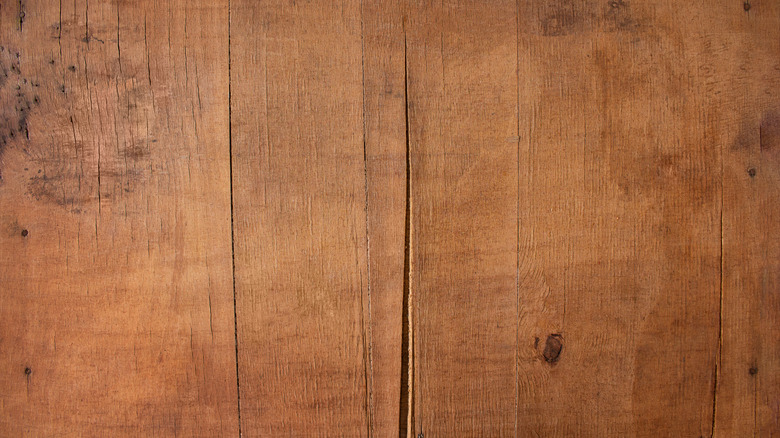The Simple DIY That Makes It Easy To Fill Gaps In Old Hardwood Flooring
Hardwood floor panels are natural, durable, and they feel great under your feet. However, because it's organic, hardwood isn't static. These floors are prone to physical changes depending on the environment and how old they are. Wood is also hygroscopic, so it tends to absorb moisture well, causing it to warp. Kitchens and bathrooms aren't ideal places for installing hardwood flooring because of this. Though gaps in wood floors can arise, the good news is that you don't need to go out of your way to hire a professional woodworker to seal them: You can handle it on your own and save that money. A simple TikTok DIY from hardwood floor company Weles Inc. will have your panels looking good as new in no time with just wood filler, a sander, and some wood stain.
Sealing gaps is something you have to consider inevitable when you have solid floors. Fixing wood gaps usually means choosing between filler or putty. Putty is great because it's malleable and can stretch to adapt to humidity changes, unlike filler, which is immovable. However, filler can be sanded down and stained while putty can't be. If your gap will require sanding and staining, use wood filler. Wood putty is for less serious repairs that won't need this. The company also used plaster in their tutorial video, which isn't necessary for these gaps because it doesn't adhere well to wood. Either way, fixing gaps is a piece of cake you can accomplish yourself.
Fill in the gaps before applying wood stain
As you prepare to bring your old, damaged hardwood back to life, make sure you get materials that are suitable for solid hardwood for the best results. In addition to wood filler, a sander, and wood stain, you'll also need some masking tape. Make sure that the wood filler and stain you get match your hardwood floor; otherwise, the fix will stick out like a sore thumb. The goal is to fill the gap and make it look seamless, so start by taping the area as close to the gap as possible. Then, stir if the filler is wet, or add water if it's dry until you reach a paste-like consistency, and spread it into the gap with a trowel. Let it sit there for about 15 minutes to harden.
Once the paste is hard, remove the tape and stick another round along the edges of the gap, this time giving it more room so that you can sand the filling down to floor level. Sweep the area for debris and apply the wood stain with a clean rag. Then remove the tape and clean off the edges. The materials will cost you $57 in total if you buy everything from scratch. You can use this method for all the gaps in your floor. Go the extra mile and improve the finishing with a $7 polyurethane topcoat from Walmart, which helps slow future damage and gives the wood a nice shine.

